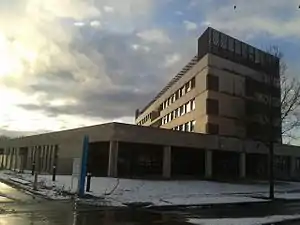FEMTO-ST Institute
The FEMTO-ST Institute (Franche-Comté Électronique Mécanique Thermique et Optique - Sciences et Technologies) is a mixed research unit associated with CNRS (UMR 6174) and attached simultaneously with:
- The University of Franche-Comté (UFC),
- École nationale supérieure de mécanique et des microtechniques (ENSMM),
- Université de technologie de Belfort-Montbéliard (UTBM).
 FEMTO-ST headquarters in Besançon, France | |
| Established | 2004 |
|---|---|
| President | Laurent Larger |
| Members | 700+ [1] |
| Address | 15B Avenue des Montboucons, Besançon (France) |
| Website | FEMTO-ST.fr/en |
FEMTO-ST is therefore a part of the association, University of Burgundy - Franche-Comté (UBFC).
History
This institute was created on January 1, 2004 from the merger of five different laboratories of unique fields including: mechanics, optics and telecommunications, electronics, time-frequency, energetics, and fluidics.[2]
In January 2012, the LIFC laboratory of the University of Franche-Comté partnered with FEMTO-ST to form a seventh department: Department of Complex Systems Computing (DISC).[3] Two years later, as a part of the TEMIS Science project, the extension works in the cleanroom was completed by increasing its area on 865 m² more to its initial extension. In 2014, the second part of the project is completed by the inauguration of the new building which hosts the headquarters and the departments of Optics and MN2S.
FEMTO-ST has also become one of the biggest research institute in the field of science of engineering in France. It has presence over Franche-Comté on the three geographical sites Besançon, Belfort, and Montbéliard.
Departments
FEMTO-ST Institute is formed by 7 departments.
Energy department [4]
It studies the production systems of conversion and storing of thermal and electric energy.
- SHARPAC : Systèmes électriques Hybrides, ActionneuRs électriques, systèmes Piles A Combustible
- Static converters
- Fuel cell systems
- PHIL – Power Hardware in the Loop
- Control and Management of Energy
- Electric actuators
- THERMIE (Thermal Science) : THermique Ecoulements instRuMentatIon et Énergie
- Metrology and Instrumentation in Fluidics and Thermal Science
- Thermal Science in energy systems
- Heat engines
- Complex flows
Micro Nano Sciences and Systems Department (MN2S) [5]
The MN2S is a department of FEMTO-ST specialized in the research on micro and nano instrumentation, nanoscience, micro and nano acoustics, microsystems and multiphysics and the micro and nanomaterials and surface. The department is located in Besançon, Montbéliard and Belfort.
Research teams :
- BioMicroDevices
- Micro-Nano-Materials and Surfaces (MINAMAS)
- Micro-Opto-Electro Mechanical Systems (MOEMS)
- Nanosciences
- Phononics and Microscopy
Complex Systems Computer Science Department (DISC) [6]
The research performed at the department are focused on E-health, micro and nanosystems dedicated to health, information safety on the complex systems, MiDi Micro and distributed intelligent nanosystems, and the transport and mobility services. The department is located in Besançon, Montéliard, and Belfort.
Research teams :
- Distributed Numerical Algorithms (AND)
- Distributed Algorithmic Collaboration, Networks, Optimization and Scheduling (CARTOON)
- Optimization, Mobility, Networking (OMNI)
- Verification and validation of software and embedded systems (VESONTIO)
Time and Frequency Department [7]
This department is specialized on high stability oscillators, acoustical-electronicals and piezoelectrics, and time-frequency metrology. It is composed by three teams:
- ACEPI : Acoustic-electronics and piezoelectrics
- CoSyMA :Composants et Systèmes Micro-Acoustiques
- OHMS : Ondes, Horloges, Métrologie et Systèmes
Automatic Control and Micro-Mechatronic Systems Department
This department is specialized in robotics, mechatronics, automatic control and artificial intelligence.
It is composed of four teams :
- Control and Design (CODE)
- Biomedical Microrobotics (MiNaRoB)
- Prognostics and Health Management (PHM)
- Sensing strategies, Perception and Characterization at the Micro-Nanoscales (SPECIMEN)
Applied Mechanics Department
The Applied Mechanics Department is focus on two main areas, which are :
- Micromechanics : materials and processes
- Structures : integration and functionalization
It then counts 11 teams, working on these 2 research areas.
Optics Department
The Optics Department works on nanometrology, near-field microscopy, integrated optics in lithium niobate, ultrafast optics, nonlinear optics, and opto-electronic dynamics.
Research groups :
- Nano-Optics (NO)
- Nonlinear Optics group (ONL)
- Optoelectroncs, Photonics and Telecommunication Optics (OPTO)
- Photonics for Medical Instrumentation (PIM)
Research quality evaluation
The institut has got an A+ score from an evaluation performed by AERES in 2010,[8] placing the institute in the list of the 30% heading research laboratories for engineering science in France.
References
- http://www.femto-st.fr/fr/L-institut/Presentation/
- "The FEMTO-ST Institute" (PDF).
- "Franche-Comté France" (PDF). p. 29. Archived from the original (PDF) on 2018-06-29. Retrieved 2018-06-29.
- http://www.femto-st.fr/en/Research-departments/ENERGY/Presentation/
- http://www.femto-st.fr/en/Research-departments/MN2S/Presentation/
- http://www.femto-st.fr/en/Research-departments/DISC/Presentation/
- http://www.femto-st.fr/en/Research-departments/TIME-and-FREQUENCY/Presentation/
- "Archived copy" (PDF). Archived from the original (PDF) on 2016-03-03. Retrieved 2015-09-06.CS1 maint: archived copy as title (link)